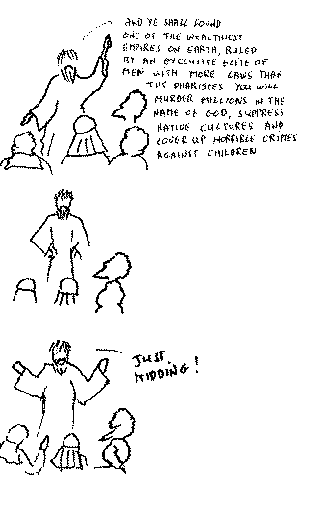On the Margins
Debbie's Church
for the Homeless
But her ordination to the priesthood was delayed because some diocesan leaders were ìunsure if street ministry was really priesthood.î
But services continue nonetheless: Thereís no choice, because this church called the Common Cathedral has no walls, and its parish is the famed Boston Common, a large, grassy down-town park. The Common Cathedralís only liturgical paraphernalia is a hand-carved cross and a portable altar. Its flock, which consists primarily of homeless men and women, would have little to offer if a collection plate were passed around. And as far as Little knows, it is the only church of its kind.
Littleís homeless congregation is joined every week by a number of non-homeless Bostonians. Together, the parishioners form a semicircle around the cross carved by a homeless churchgoer. ìThis community is concretely acting out the Christian belief,î Little says.
On a recent Sunday, she wears a white shirt with a clerical collar and casual gray pants. On her feet are sandals without socks. A sticker advertising the Walk for Hunger, a local fund-raiser, adorns her pants. Services continue as the music from the boom box fades. A tourist snaps a photograph of the assembly and continues on his way.
Common Cathedral was born on Easter Sunday 1996, when Little covered a cart with a slab of plywood and used it as an altar for offering Holy Communion to about 17 homeless people on the common. The inspiration for the ministry to the homeless came on Maundy Thursday, the day Christians believe Jesus celebrated the Last Supper. As she passed the Common, Little says, she thought about Jesus ìalways going to people to be with them.î The church, she remembers thinking, ìis out here.î
Since then, the weekly gatherings have grown to include about 30 homeless people and nearly as many who are not homeless. Little also counts as part of her congregation about 100 others who gather near the prayer circle but do not actively participate. She keeps the service intentionally informal, with plenty of opportunities for personal reflection and prayer.
A woman steps forward from the circle and speaks loudly and forcefully. ìThe Lord is God,î she says. ìHeís in my heart, and I understand him. I just want to tell you one thing. No matter what color of the rainbow, God is good.î The woman embraces Little, and with a smile returns to the circle. The worship service continues.
Initially, Little says, she used the Episcopal Book of Common Prayer, but soon started relying on words of worship that were ìin the bonesî of her homeless flock ó Psalm 23, the Lordís Prayer, and the ìSerenity Prayerî popular with 12-step meetings. The hymns sung during weekly services include ìWe Are Standing on Holy Ground,î ìKumbaya,î and ìWe Shall Overcome.î Such continuity is important.
ìItís the only time I can come and forget all thatís going on around me,î says Gary Huber, 44-year-old Common Cathedral regular. Huber carved the cross and built the altar. He usually sleeps in his truck or in doorways. He cleans up in a friendís house before church every Sunday ó often his only chance to shower all week. ìItís true. Itís real. It doesnít change,î Huber says of Common Cathedral. ìNo matter what happens in my life, this has never left me.î
To some of the non-homeless attending Common Cathedral, the services offer a glimpse of society as the Gospel intended. ìThere isnít a separation of who is in what denomination, whoís in what building, whoís in and out,î says Sophronia Camp, a resident of nearby Cambridge. Camp, a mother of five, attends services at St. Peterís Episcopal Church in Cambridge with her family on Sunday mornings before praying at Common Cathedral in the afternoon. ìItís a big contrast,î she says. ìBut itís not a conflict.î
Little had dedicated herself to Bostonís least affluent citizens even before that first Easter service three years ago. After a quarter-century in communications and management, she left a job at Harvard Law School to attend an Episcopal seminary and was ordained a deacon in 1994. But her ordination to the priesthood was delayed because some diocesan leaders were ìunsure if street ministry was really priesthood.î
After much debate, she was ordained a priest in 1995. She began distributing peanut butter sandwiches to the homeless at South Station, Bostonís main railroad terminal. On Christmas that year, she offered the Eucharist for the first time to about ten people in South Station, a tradition that continued through the winter and gradually gained the support of the diocese.
Today, the peanut butter sandwiches are a tradition. After services, the cloth comes off the altar, and it becomes a lunch table, serving sandwiches and vegetables. Donated clothing, piled at the foot of the cross, is also available, as is legal advice from a volunteer lawyer and health care from a nurse. ìI think of that as part of the service,î Little says. ìIf someone is wearing shoes two sizes too small, I have a hard time living with that.î
During the week, she visits members of the ìparishî in the hospital or jail, or attends court hearings with them. She says she never considered bringing the services inside any of downtown Bostonís nearby churches.îChurch is where the people are,î she says. ìMost people tell me theyíve felt or been rejected or not welcomed at traditional churches.î
Larry Craft, 57, a Common Cathedral regular, cannot imagine the services being held anywhere else. Formerly homeless, he calls himself a lay minister and wears a clerical collar. ìI come to get fed, fed by the word of God,î he says. ìAnd that way, I can pass it on to other people. It keeps me straight and keeps me sober, and I love it.î
Further information is available from the website: www.ecclesia-ministries.org. Ecclesia Ministries, 35 Bowdoin Street, Boston, MA 02114, USA. Tel. +(617) 523 7875. E-mail: info@ecclesia-ministries.org

by Peter Dorman